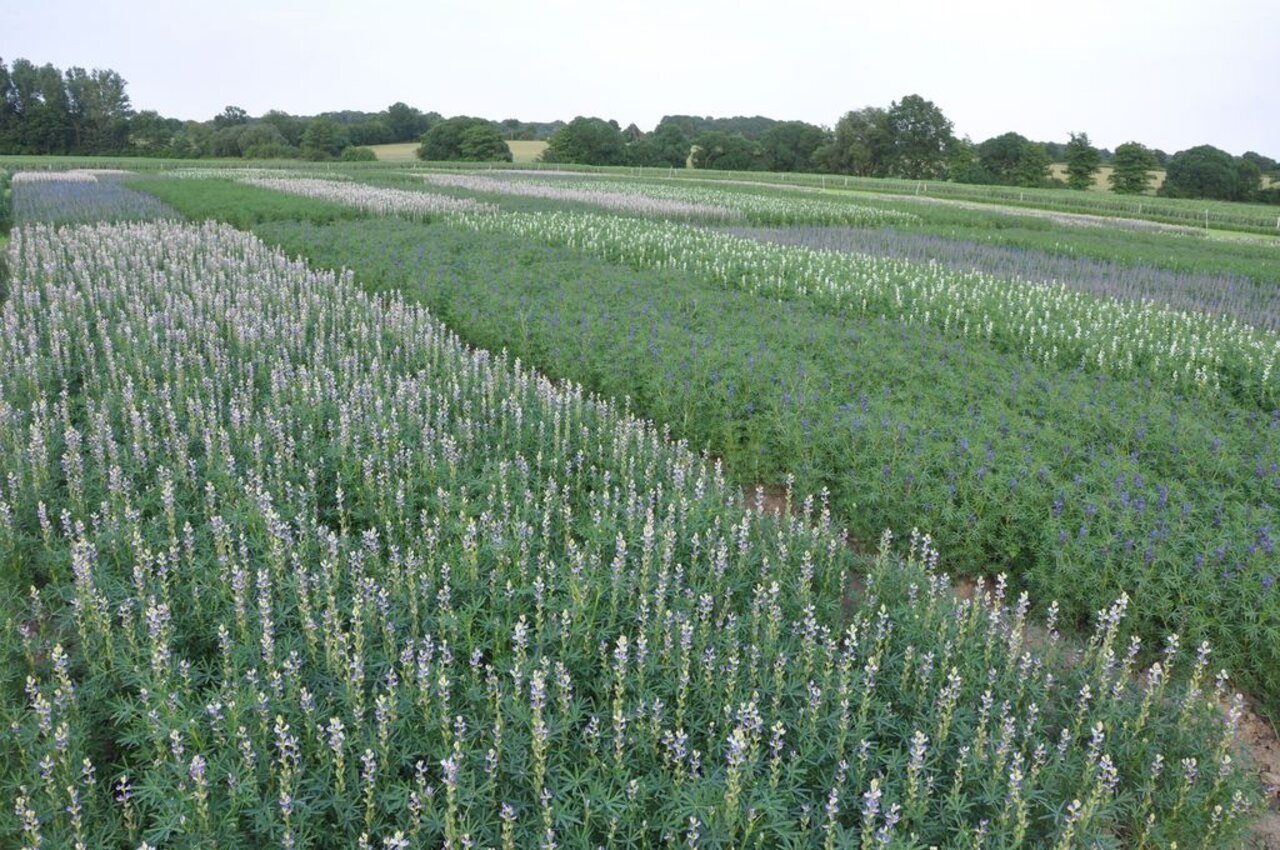Project
Peas, lupins and partners in field trials

Optimisation of organic grain legume production
Legumes are essential in the system of organic farming because of the nitrogen fixation and their function for the nutrient supply. They improve soil fertility, and provide a protein-rich feed stuff. In field trials with the focus of mixed cropping of grain legumes, especially the cultivation of blue lupins and peas we focused on yield optimisation and weed management. , We also evaluated the feed quality and their contribution to protein supply in organic animal husbandry.
Background and Objective
Yields of organically grown grain legumes are very variable from year to year. Furthermore, declining yields are observed in practice for several years. Due to this situation, a decrease of organically cultivated grain legumes is evident. On the other hand, a much higher demand for grain legumes as a protein-rich feed is needed due to the increased demand of organically produced meat and eggs. For a higher production of locally produced, high-protein animal feedstuff in the near future, we develop cropping strategies for optimizing the production of grain legumes with the aim of high and stable yields.
Approach
In field trials at the site Trenthorst, we examine various options for optimizing the cultivation of all major grain legume species: faba bean, pea, lupine and common vetch. We focus on the development of strategies for a more effective weed and pest control as well as the cultivation of alternative grain legumes such as the cultivation of winter forms of pea, common vetch and White Lupine. The emphasis in this context is the development of intercropping systems and of cultivation methods for optimizing the direct weed control.
Results
The cultivation of grain legumes in mixed cropping is a very effective, indirect method of weed control in grain legumes. Yield can be stabilized, but the cultivation strategy depends on the species of grain legume and the partner crop.
In Blue lupines, the use of mechanical hoe in wider row distances showed a good possibility of direct weed control.
Involved Thünen-Partners
Involved external Thünen-Partners
- Friedrich-Loeffler-Institut, Bundesforschungsinstitut für Tiergesundheit (FLI)
(Greifswald-Insel Riems, Braunschweig, Celle, Deutschland) - Julius Kühn-Institut - Bundesforschungsinstitut für Kulturpflanzen (JKI)
(Quedlinburg, Braunschweig, Groß Lüsewitz, Kleinmachnow, Deutschland)
Duration
1.2003 - 12.2024
More Information
Project status:
finished
Publications
- 0
Böhm H, Rinke N, Aulrich K (2024) Screening verschiedener Sorten der Saatwicke im Gemengeanbau mit Weizen als Druschkultur. In: Bruder V, Röder-Dreher U, Breuer L, Herzig C, Gattinger A (eds) Landwirtschaft und Ernährung - Transformation macht nur gemeinsam Sinn : 17. Wissenschaftstagung Ökologischer Landbau, 5.-8. März 2024, Justus-Liebig-Universität Gießen ; Tagungsband. 1. Auflage. Frankfurt am Main: FiBL Deutschland eV, pp 158-160, DOI:10.5281/zenodo.11204339
- 1
Böhm H (2023) Anbaustrategien für Körnerleguminosen. Öko Aktuell(75):2-4
- 2
Böhm H, Homfeldt L, Rinke N (2023) Wirkung von Rhizobien-Impfmitteln auf Ertragsparameter und Rohproteinertrag der Schmalblättrigen Lupine. In: Bibic V, Schmidtke K (eds) One step ahead - einen Schritt voraus! : Beiträge zur 16. Wissenschaftstagung Ökologischer Landbau, 07.-10. März 2023, Frick (CH), FiBL Campus. 1. Auflage. Berlin: Verlag Dr Köster, pp 296-299
- 3
Rinke N, Böhm H (2022) Einfluss des Gemengeanbaus verschiedener Körnerleguminosen auf die photosynthetisch-aktive Strahlung (PAR) im Bestand und die Unkrautunterdrückung unter Bedingungen des ökologischen Landbaus. Julius Kühn Arch 468:456-460, DOI:10.5073/20220125-060136
- 4
Rinke N, Kautz T, Aulrich K, Böhm H (2022) The effect of long-and short-stemmed oat in vetch-oat intercropping on weed infestation, agronomic performance, and grain quality in low input systems. Eur J Agron 140:126611, DOI:10.1016/j.eja.2022.126611
- 5
Rinke N, Böhm H (2021) Einfluss des Gemengeanbaus auf die Erträge und Rohproteinerträge verschiedener Körnerleguminosen im Ökolandbau. Mitt Gesellsch Pflanzenbauwiss 32:72-73
- 6
Seeger JN, Astor T, Ziebell H, Then C, Böhm H, Saucke H (2021) Einsatz multispektraler Drohnenfotos zur Detektion und Ertragsabschätzung von Nanovirusinfektionen (PNYDV) in Ackerbohne (Vicia faba L.). Julius Kühn Arch 467: 420
- 7
Rinke N, Böhm H (2021) Weed suppression and yield of sole and intercropped grain legumes under the conditions of organic farming. Asp Appl Biol 146:17-25
- 8
Böhm H, Dauber J, Dehler M, Amthauer Gallardo DA, Witte T de, Fuß R, Höppner F, Langhof M, Rinke N, Rodemann B, Rühl G, Schittenhelm S (2020) Fruchtfolgen mit und ohne Leguminosen: ein Review. J Kulturpfl 72(10-11):489-509, DOI:10.5073/JfK.2020.10-11.01
- 9
Rinke N, Böhm H (2019) Bewertung des Gemengeanbaus von Saatwicken mit Hafer anhand des Kornertrages und der Konkurrenzkraft der Mischkultur. Mitt Gesellsch Pflanzenbauwiss 31:59-60
- 10
Rinke N, Böhm H (2019) Intercropping of grain legumes with spring oat (Avena sativa L.) increases weed control and total yields in organic farming. In: Third International Legume Society Conference ILS3 2019 : Legumes for human and planet health ; Book of abstracts, Poznan 2019. p 43
- 11
Seeger JN, Ziebell H, Amari K, Then C, Möckel T, Grüner E, Sturm B, Nasirahmadi A, Shrestha L, Böhm H, Saucke H (2019) On-farm Untersuchungen zum Nanovirus PNYDV (Pea necrotic yellow dwarf virus) an Ackerbohne (Vicia faba). In: Mühlrath D, Albrecht J, Finckh M, Hamm U, Heß J, Knierim U, Möller D (eds) Innovatives Denken für eine nachhaltige Land- und Ernährungswirtschaft : Beiträge zur 15. Wissenschaftstagung Ökologischer Landbau ; Kassel, 5. bis 8. März 2019. Berlin: Köster, pp 156-157
- 12
Böhm H, Bojahr J (2018) Die Ertragsfähigkeit wird oft unterschätzt : Lupinen mit und ohne Pflanzenschutz anbauen. Landwirtschaftl Wochenbl Hessenbauer 227(10):29-32
- 13
Böhm H, Bojahr J (2018) Lupinen wagen. Land Forst 171(10):39-41
- 14
Böhm H, Bojahr J (2018) Lupinenanbau - ein Wagnis? : die Leistungsfähigkeit wird oft unterschätzt. Bauernbl Schleswig-Holstein Hamburg 72/168(11):42-44
- 15
Seeger JN, Ziebell H, Amari K, Then C, Möckel T, Grüner E, Sturm B, Nasirahmadi A, Shrestha L, Böhm H, Saucke H (2018) Neue Erkenntnisse zum Nanovirus PNYDV in Ackerbohne und Erbse. Julius Kühn Arch 461:159-160, DOI:10.5073/jka.2018.461.000
- 16
Böhm H, Aulrich K (2017) Ertragsleistung, Proteingehalte und -erträge und Winterhärte von Winterformen der Erbsen (Pisum sativumL.) im Gemenge mit Triticale. Mitt Gesellsch Pflanzenbauwiss 29:22-23
- 17
Böhm H (2017) Legumes as mix partner make a perfect organic crop. In: Sammendrag : Plantekongres 2017 : 17.-18. Januar. Koebenhavn: Koebenhavns Universitet, pp 236-237
- 18
Böhm H (2017) Saatwicke: Unterschätzte Körnerleguminose : Wickengemenge erzielen gute bis sehr gute Rohproteinerträge und unterdrücken Beikraut erfolgreich. Bio Land(2):8-10
- 19
Gronle A, Böhm H (2017) Trumpf gegen Erbsenblattläuse. Bio Land(1):14-15
- 20
Witten S, Aulrich K, Böhm H (2016) Effect of sulfur fertilization and variety on yield and contents of crude protein and amino acids of organically produced blue lupins (Lupinus angustifoliusL.). In: Legumes for a Sustainable World : ILS2 ; Second International Legume Society Conference ; 11th - 14th October 2016 ; Troia Resort, Portugal ; Book of Abstracts. Lisboa: Universidade Nova, p 254
- 21
Böhm H, Aulrich K (2016) Evaluation of different organically cultivated grain legumes in Northern Germany. In: Legumes for a Sustainable World : ILS2 ; Second International Legume Society Conference ; 11th - 14th October 2016 ; Troia Resort, Portugal ; Book of Abstracts. Lisboa: Universidade Nova, p 253
- 22
Aulrich K, Böhm H, Witten S (2016) Investigations on crude protein and amino acids in organically produced field pea (Pisum sativumL.) varieties. In: Legumes for a Sustainable World : ILS2 ; Second International Legume Society Conference ; 11th - 14th October 2016 ; Troia Resort, Portugal ; Book of Abstracts. Lisboa: Universidade Nova, p 135
- 23
Böhm H (2015) Anbau von Wintererbsen unter norddeutschen Standortbedingungen. In: Häring AM, Hörning B, Hoffmann-Bahnsen R, Luley H (eds) Beiträge zur 13. Wissenschaftstagung Ökologischer Landbau "Am Mut hängt der Erfolg: Rückblicke und Ausblicke auf die ökologische Landbewirtschaftung". pp 63-65
- 24
Böhm H (2015) Ertragsleistung, Proteingehalte und -erträge von Saatwicken im Vergleich zu Erbse, Ackerbohne und Lupine. In: Häring AM, Hörning B, Hoffmann-Bahnsen R, Luley H (eds) Beiträge zur 13. Wissenschaftstagung Ökologischer Landbau "Am Mut hängt der Erfolg: Rückblicke und Ausblicke auf die ökologische Landbewirtschaftung". pp 66-67
- 25
Böhm H (2014) Bedeutung von Körnerleguminosen für den ökologischen Landbau. Raps(Spezial Körnerleguminosen):8-9
- 26
Böhm H (2014) Ertragsleistung und Winterhärte von Winterformen der Erbsen (Pisum sativum L.) unter norddeutschen Standortbedingungen. Mitt Gesellsch Pflanzenbauwiss 26:102-103
- 27
Böhm H (2014) Unkraut unterdrückende Wirkung von Saatwicken in Reinsaat und im Gemengeanbau mit Hafer in Abhängigkeit von Aussaatstärkenverhältnis und Wickensorte. Julius Kühn Arch 443:493-497, doi:10.5073/jka.2014.443.061
- 28
Böhm H (2013) Anbau der Saatwicke (Vicia sativa L.) im Gemenge mit Hafer - eine Alternative in der Körnerleguminosenproduktion? Mitt Gesellsch Pflanzenbauwiss 25:80-81
- 29
Böhm H, Ebert U, Vogt-Kaute W (2013) Körnerleguminosen im Gemenge. KTBL Heft 100:21-23
- 30
Aulrich K, Böhm H (2012) Quality of organic legumes - prediction of main ingredients and amino acids by Near-Infrared Spectroscopy. Landbauforsch SH 362:401-403
- 31
Böhm H, Aulrich K (2011) Effects of different row distances and seed densities on yield and quality of blue lupin (L. Angustifolius)in organic farming. In: Naganowska B, Kachlicki P, Wolko B (eds) Lupin crops - an opportunity for today, a promise for the future : proceedings of the 13th International Lupin Conference, 6-10 June 2011, Poznan, Poland . Canterbury: International Lupin Association, pp 144-148
- 32
Böhm H (2010) Heimische Körnerleguminosen - Grundlage für Ackerbau und Tierernährung. Lebendige Erde 61(4):20-23
- 33
Böhm H, Aulrich K (2009) Anbau der Blauen Lupine (Lupinus angustifolius) mit unterschiedlichen Reihenabständen und Bewertung der Futterqualität mittels NIRS. In: Mayer J, Afföldi T, Leiber F (eds) Beiträge zur 10. Wissenschaftstagung Ökologischer Landbau : Werte - Wege - Wirkungen: Biolandbau im Spannungsfeld zwischen Ernährungssicherung, Markt und Klimawandel ; Bd. 1: Boden, Pflanzenbau, Agrartechnik, Umwelt und Naturschutz, Biolandbau international, Wissensmanagement. Berlin: Köster, pp 127-130
- 34
Böhm H (2009) Körnerleguminosen - Stand des Wissens sowie zukünftiger Forschungsbedarf aus Sicht des Ökologischen Landbaus. J Kulturpfl 61(9):324-331
- 35
Böhm H (2009) Körnerleguminosen in Bedrängnis. Ökologie & Landbau 37(152):14-17
- 36
Böhm H, Bramm A, Aulrich K, Rühl G (2008) Effect of different sowing densities in mixed cultivation of blue lupin (Lupinus Angustifolius) with spring crops in yield and quality. In: Palta JA, Berger JD (eds) Lupins for health and wealth : 12th International Lupin Conference , Fremantle, Western Australia, 14-18 September 2008. Canterbury: International Lupin Association, pp 42-46
- 37
Berk A, Bramm A, Böhm H, Aulrich K, Rühl G (2008) The nutritive value of lupins in sole cropping systems and mixed intercropping with spring cereals for grain production. In: Palta JA, Berger JD (eds) Lupins for health and wealth : 12th International Lupin Conference , Fremantle, Western Australia, 14-18 September 2008. Canterbury: International Lupin Association, pp 66-70
- 38
Böhm H, Bramm A, Aulrich K, Rühl G (2008) Yield and predicted feed quality of different German cultivars of blue lupins (Lupinus Angustifolius). In: Palta JA, Berger JD (eds) Lupins for health and wealth : 12th International Lupin Conference , Fremantle, Western Australia, 14-18 September 2008. Canterbury: International Lupin Association, pp 118-122
- 39
Böhm H, Aulrich K, Berk A (2007) Amino acid composition in organically grown grain legumes and cereals. Proc Soc Nutr Physiol 16: 88
- 40
Bramm A, Böhm H, Pahlow G, Berk A (2006) Alternatives for the production of forage protein. In: Santen E van, Hill GD (eds) México, where Old and New World lupins meet : proceedings of the 11th International Lupin Conference, Guadalajara, Jalisco, México, 4-9 May, 2005. Canterbury: International Lupin Association, pp 209-213

![[Translate to English:] [Translate to English:]](/media/_processed_/8/e/csm_Bildschirmfoto_2021-03-03_bearb_fc48ac88bf.jpeg)
![[Translate to English:] [Translate to English:]](/media/_processed_/8/e/csm_Bildschirmfoto_2021-03-03_bearb_ba3ec0e9d7.jpeg)






